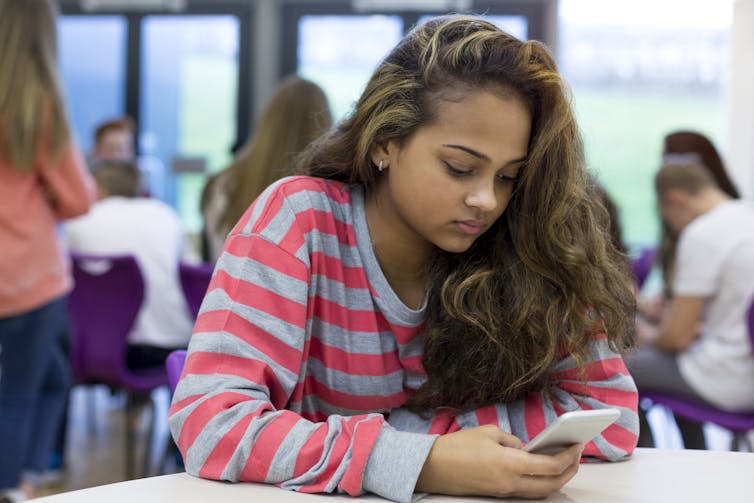Cyberflashing is now a criminal offence – but the normalisation of this behaviour among young people needs to change

In March 2024, a 39-year-old man became the first person in England and Wales to be convicted of the new offence of cyberflashing, part of the Online Safety Act. He had sent unsolicited photos of his genitals to a 15-year-old girl and a woman.
Cyberflashing now being a criminal offence is a welcome change, and the creation of this offence was informed by our research.
But as researchers of young people’s use of social media, we have concerns that this is not enough to to counter the widespread normalisation of image-based sexual harassment and abuse, including digital flashing, in youth culture. A significant problem is that young people rarely report that they have encountered this – and without reports, no convictions can take place.
In 2019, we researched cyberflashing interviewing 144 teens about their experiences of non-consensual sexual images on social media platforms. We followed this research up with a survey of 336 young people, carried out during the pandemic lockdown of spring and summer 2020.
Together, the interviews and survey data present a compelling picture of how widespread cyberflashing is among young people.
We found that 75% of girls from our qualitative interviews had received some form of unwanted male genital images or videos. One 14-year-old girl said:
There was this guy on Snapchat, I didn’t know him but I thought my friend knew him, so I accepted this follow request and then on his story it was like who wants to see my big… you know, and then I saw like a text from him, because you know you do so I thought it was like a streak [an ongoing chat conversation], so when I pressed on it and it was a picture of his like dick […] I blocked him.
In our survey, we found that 37% of girls had been sent an unwanted sexual image and of these 80% said it left them feeling “disgusted”.
The survey also found that young people rarely reported their experiences. Only 17% of the young people in our survey reported cyberflashing to social media platforms, 5% told their parents and just 2% reported it to school.

A 15-year-old girl explained in an interview that normalisation and acceptance of the issues plays a role in lack of reporting:
[Young people] they think it’s normal … yeah, it’s normal, or they didn’t do anything, and that is sexual assault, but most teenagers don’t know that, so they don’t do anything about it, and they just leave it.
In our interviews, girls explained that while images from strangers were often upsetting, they felt better able to ignore or block such images than when they came from boys they knew. It was much worse for victims if the sender was in their immediate peer group at school. A 13-year-old said:
Yeah, if they go to the same school as you then you see them every day, and it just reminds you of like what they did.
In some cases, the harassment comes from boys the girls are close to. A 14-year-old said:
I had a friend, yeah, and her boyfriend must have sent her a dick pic, and then he carried on trying to pressure her to send one, I feel that’s what happens the most, these boys try and pressure them like into sending it back, because oh I send, or oh if you love me you’ll send it back to me.
These “transactional dick pics” are a doubled form of harassment: girls are being cyberflashed accompanied by requests to send sexual content back. Our survey found that girls felt much more pressure to send nudes (44%) than boys (15%).
A new criminal offence is a good step, but it doesn’t sufficiently address the culture shift that is so desperately needed.
Recommended changes
More extensive privacy settings for social media sites would be a start, given our research showed incidents of image-based sexual harassment and abuse from unknown adults as well as peers.
Sex education at school should also give young people the tools to understand harassment online and digital consent. The current updated government guidance on education regarding sharing nudes and semi nudes does include a footnote to our own online sexual harassment guidance. But the government document still does not adequately cover basic elements of image-based sexual harassment and abuse including cyberflashing, upskirting and AI deepfakes.
Parents and adults in the wider community need resources to help them understand and respond to tech facilitated abuse, including how to talk to young people about these issues.
We have produced lesson plans and resources for schools. In the evaluation report of these resources, young people, school staff and parents had vastly improved their understandings of digital sexual violence and bystander interventions.
Schools need to take an approach that builds in understanding of the impact of trauma on young people. It’s also vitally important that boys are included in this discussion. Excluding boys and boys’ voices may push them deeper into misogynistic ideologies. Creating peer mentorship programmes and setting up youth discussion groups within schools around issues of digital consent are effective ways to shift attitudes.
A focus on education will help young people know their rights and give them the tools they need to stay safe.
This article is republished from The Conversation under a Creative Commons license. Read the original article.

The authors do not work for, consult, own shares in or receive funding from any company or organisation that would benefit from this article, and have disclosed no relevant affiliations beyond their academic appointment.

 Yahoo News
Yahoo News 
